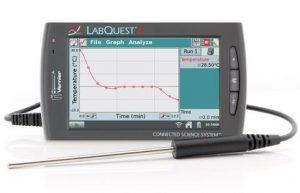A commonly asked question among students in math classes is “how will I ever use this in real life?” Math is extremely applicable to real world problems, but students do not always realize just how useful it can be. For this reason, modeling real world, hands on problems is an extremely effective strategy to engage students in learning concepts, and it shows them the relevance of math concepts in the real world. For this assignment, students will use Vernier temperature probes and a LabQuest2 to model and compare the temperature change of hot water and boiling water.
In this activity, students will use two temperature probes simultaneously to record the temperatures of boiling and hot water. They will record the temperatures over the span of two minutes and use the LabQuest2 to generate linear equations for each cup of water (boiling and hot). They will record the equation for each cup and graph the two lines on the same graph. After recording their data, they will discuss and answer questions about the equations they found. First, they will work with their partner to decide which cup of water is cooling faster. Then they will compare the two lines and equations to determine whether the lines are parallel or intersecting and find where the two equations intersect. Lastly, they will show their ability to create their own linear equation using two given points. The students will display their understanding of the following CCSS by analyzing the real world data from the activity.
CCSS.MATH.CONTENT.HSA.CED.A.2
Create equations in two or more variables to represent relationships between quantities; graph equations on coordinate axes with labels and scales.
